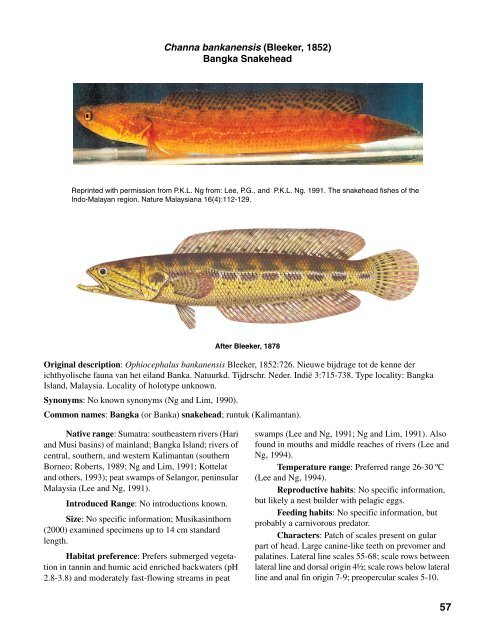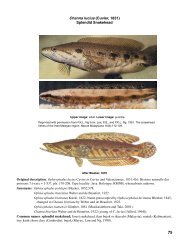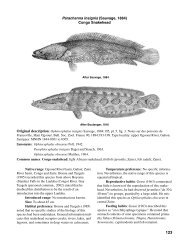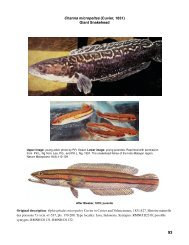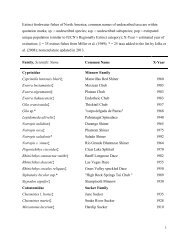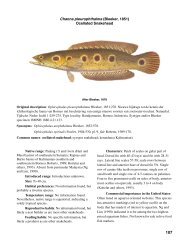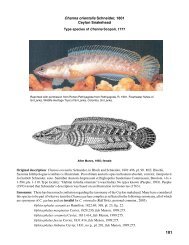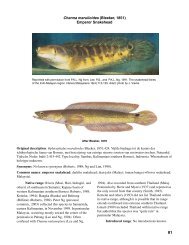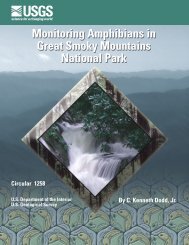Channa bankanensis (Bleeker, 1852) Bangka Snakehead
Channa bankanensis (Bleeker, 1852) Bangka Snakehead
Channa bankanensis (Bleeker, 1852) Bangka Snakehead
You also want an ePaper? Increase the reach of your titles
YUMPU automatically turns print PDFs into web optimized ePapers that Google loves.
<strong>Channa</strong> <strong>bankanensis</strong> (<strong>Bleeker</strong>, <strong>1852</strong>)<strong>Bangka</strong> <strong>Snakehead</strong>Reprinted with permission from P.K.L. Ng from: Lee, P.G., and P.K.L. Ng. 1991. The snakehead fishes of theIndo-Malayan region. Nature Malaysiana 16(4):112-129.After <strong>Bleeker</strong>, 1878Original description: Ophiocephalus <strong>bankanensis</strong> <strong>Bleeker</strong>, <strong>1852</strong>:726. Nieuwe bijdrage tot de kenne derichthyolische fauna van het eiland Banka. Natuurkd. Tijdrschr. Neder. Indië 3:715-738. Type locality: <strong>Bangka</strong>Island, Malaysia. Locality of holotype unknown.Synonyms: No known synonyms (Ng and Lim, 1990).Common names: <strong>Bangka</strong> (or Banka) snakehead; runtuk (Kalimantan).Native range: Sumatra: southeastern rivers (Hariand Musi basins) of mainland; <strong>Bangka</strong> Island; rivers ofcentral, southern, and western Kalimantan (southernBorneo; Roberts, 1989; Ng and Lim, 1991; Kottelatand others, 1993); peat swamps of Selangor, peninsularMalaysia (Lee and Ng, 1991).Introduced Range: No introductions known.Size: No specific information; Musikasinthorn(2000) examined specimens up to 14 cm standardlength.Habitat preference: Prefers submerged vegetationin tannin and humic acid enriched backwaters (pH2.8-3.8) and moderately fast-flowing streams in peatswamps (Lee and Ng, 1991; Ng and Lim, 1991). Alsofound in mouths and middle reaches of rivers (Lee andNg, 1994).Temperature range: Preferred range 26-30 ºC(Lee and Ng, 1994).Reproductive habits: No specific information,but likely a nest builder with pelagic eggs.Feeding habits: No specific information, butprobably a carnivorous predator.Characters: Patch of scales present on gularpart of head. Large canine-like teeth on prevomer andpalatines. Lateral line scales 55-68; scale rows betweenlateral line and dorsal origin 4½; scale rows below lateralline and anal fin origin 7-9; preopercular scales 5-10.57
Dorsal fin rays 31-45, anal fin rays 20-31. Superficiallyresembles <strong>Channa</strong> lucius, head taller and more blunt inC. <strong>bankanensis</strong> (see Ng and Lim, 1990, p. 142, fig. 5C,D), and body more compressed in C. lucius (Lee andNg, 1991). Somewhat rounded, dark blotch on operculumof adult, not elongated as in C. lucius (Ng andLim, 1990).Commercial importance in the United States:Not listed on aquarist-oriented websites.Commercial importance in native range:Probably not of commercial importance due to habitatpreferences. Lee and Ng (1991) stated that this speciesis not popular with local anglers due to its small size.Environmental concerns: Unknown, but probablya predator on other fishes and invertebrates. Habitatpreferences indicate the species might only become problematicin highly acidic waters. Stoye (1935) mentionedavailability of this species as an aquarium fish.100° E120°E140°EChinaEXPLANATIONDISTRIBUTION OF<strong>Channa</strong> <strong>bankanensis</strong>Native range20°N0°MyanmarPACIFICOCEANLaosThailandPhilippinesVietnamCambodiaMalaysiaMalaysiaINDIANOCEANIndonesiaEquator0 500 MILES0 500 KILOMETERSScale is approximateIndonesia<strong>Channa</strong> <strong>bankanensis</strong>Indonesia58
<strong>Channa</strong> baramensis (Steindachner, 1901)Baram <strong>Snakehead</strong>After Steindachner, 1901Live coloration (14.7 cm)Reprinted with permission from H.H. Ng and P.K.L. Ng from: Ng, H.H., and others, 1996. Revalidation of<strong>Channa</strong> baramensis (Steindachner, 1901), a species of snakehead from northern Borneo (Teleostei:Channidae). Sarawak Mus. J. 48(69 n.s.):219-226.Original description: Ophicephalus baramensis Steindachner, 1901:435, pl. 17. Kükenthal’s Ergebnnisse einerzoologischen Forschungriese in den Molukken und Borneo. Abh. Senckenb. Naturforsch. Ges. 25:409-464,pls. 17-18. Type locality: Baram River, northern Sarawak (northern Borneo). Syntypes: SMF 860; SMF 8473.Synonyms: Ophicephalus melasoma (<strong>Bleeker</strong>, 1851) fide Weber and de Beaufort (1922); Myers and Shapovalov(1932); Roberts (1989); Ng and Lim (1990); and Rainboth (1996). Ng and others (1996) revalidated the species andMusikasinthorn (2000) also recognized the species as valid.Common names: Baram snakehead; barama snakehead.59
Native range: Northern Sarawak, Brunei, andwestern Sabah (northern Borneo). Also occurs in theSadong basin, southern Sarawak, and the Segamabasin, eastern Sabah (Martin-Smith and Hui, 1998).Introduced range: None.Size: To about 22 cm.Habitat preference: Known from blackwaterswamps (Ng and others, 1996) and small to moderatesizedstreams, clear or turbid, in secondary growth orforest areas (Inger and Kong, 1962).Temperature range: No specific information,but native range is tropical (about 3-6º N).Reproductive habits: Habits can be inferredfrom those of its closest relative, <strong>Channa</strong> melasoma.Doubtlessly a nest builder like other channids withprobably only one parent guarding eggs and young.Likely a nocturnal species.Feeding habits: Like <strong>Channa</strong> melasoma, probablya nocturnal thrust predator that feeds on otherfishes, small reptiles, crabs, insects and insect larvae.Characters: No patch of scales on gular region.Dorsal fin rays 38-40; anal rays 23-26. Predorsal scales8-9; lateral line scales 51-52. This species appears to bemost closely related to <strong>Channa</strong> melasoma, and somecharacters overlap in both species (Ng and others,1996). Nevertheless, adults (120 mm or more standardlength) can be separated as follows: Lateral headprofile of C. melasoma distinctly sharper. Postorbitaldepth greater in C. baramensis than in C. melasoma(33.3-34.1 percent of head length versus 27.9-31.8percent of head length in C. melasoma) (Ng and others,1996). There are also distinct differences in coloration.In closely related C. melasoma and C. cyanospilos,black pigment (melanin) appears as evenly spread overeach scale, whereas in C. baramensis, melanin isconcentrated in the central part of most scales in adultsand most specimens smaller than 120 mm standardlength. Moreover, there is a distinct barred pattern onthe caudal fin in adult C. baramensis that is absent inC. melasoma and C. cyanospilos of similar lengths.This character, however, cannot be used to identifyspecimens smaller than about 120 mm standard length(Ng and others, 1996).Commercial importance in the United States:Unknown to have been imported for any purpose.Commercial importance in native range:Reported as caught by anglers, indicating use as a foodfish (Ng and others, 1996). Probably only of minorcommercial importance.Environmental concerns: This species is probablya nocturnal thrust predator. Its limited range in thetropics would restrict its ability to establish in all butthe warmest waters of the U.S.100° E120°E140°EChinaEXPLANATIONDISTRIBUTION OF<strong>Channa</strong> baramensisNative range20°N0°MyanmarPACIFICOCEANLaosThailandPhilippinesVietnamCambodiaMalaysiaMalaysiaINDIANOCEANIndonesiaEquator0 500 MILES0 500 KILOMETERSScale is approximateIndonesiaIndonesia<strong>Channa</strong> baramensis60
<strong>Channa</strong> barca (Hamilton, 1822)Barca <strong>Snakehead</strong>After Hamilton, 1822Original description: Ophiocephalus barca Hamilton, 1822:67, pl. 35, fig. 20. An account of the fishes found inthe River Ganges and its branches. Edinburgh and London. i-vii + 1-405, pls. 1-39. Type locality: BrahmaputraRiver, near Goalpara, Assam, India. Types unknown.Synonyms: Ophicephalus nigricans Cuvier, 183:431.Common name: barca snakehead.Native range: Endemic to Ganges andBrahmaputra River basin, India and Bangladesh(Musikasinthorn, 2000). Bhuiyan (1964) cited itspresence in eastern and some areas of western Pakistanbut this may be a misidentification.Introduced range: No introductions known.Size: To 90 cm (Talwar and Jhingran, 1992).Habitat preference: Large rivers (Talwar andJhingran, 1992).Temperature range: No specific information.Nevertheless, its native range is located between about25-27º N, suggesting it is a warm temperate species.Reproductive habits: No detailed information,but like other snakehead species, it is assumed to cleara nest in nearshore vegetation, lay pelagic eggs which,following fertilization, rise to the surface where theyare guarded vigorously by one or both parents untilhatching.Characters: Body elongated, mostly rounded.Mouth large; lower jaw with a few canines behind asingle row of villiform teeth that widen to 5 or 6 rowsat jaw symphysis; 2 or 3 large teeth on vomer and someon palatines. Scales on top of head large; 9 scale rowsbetween preopercular angle and posterior border oforbit; predorsal scales 15; 60 to 65 scales in longitudinalseries. Dorsal fin rays 47-52; anal fin rays 34-36;pectoral rays 16; pelvic fin rays 6. Life colors violet onback fading to dull white with purple cast on sides;back and sides with large black blotches, as are dorsal,anal, and caudal fins; fin edges red; pectoral fins redwith numerous black spots.Commercial importance in the United States:Typically not listed on aquarist-oriented websites.Likelihood of being imported for sale in aquarium fishtrade or live-food fish markets has been low to probablynonexistent.Commercial importance in native range:While reported as common in the Brahmaputra River,Assam, India, it is said to be of minor importance as afishery resource. Nevertheless, it is considered anexcellent food fish (Talwar and Jhingran, 1992).Environmental concerns: Like other snakeheads,adults are carnivorous predators, most preferringother fishes as food.61
80° E100°ENepalBhutanChinaEXPLANATIONDISTRIBUTION OF<strong>Channa</strong> barcaNative range20°N0 1,000 MILESIndiaBangladeshBay ofBengalMyanmarLaosThailand01,000 KILOMETERSScale is approximateThailandVietnamCambodiaMalaysia0°EquatorIndonesia<strong>Channa</strong> barca62
<strong>Channa</strong> bleheri Vierke, 1991Rainbow <strong>Snakehead</strong>Reprinted with permission from Jörg Vierke from: Vierke, Jörg. 1991a. Ein farbenfroher neuerschlangenkopffish aus Assam <strong>Channa</strong> bleheri spec. nov. Das Aquarium 259:21.Original description: <strong>Channa</strong> bleheri Vierke, 1991a:20-24. Ein farbenfroher neuer Schlangenkopffisch aus Assam<strong>Channa</strong> bleheri spec. nov. Das Aquarium 259:20-24. Type locality: upper part of Dibru River, near Guijan,Brahmaputra River basin, northeastern Assam, India. Holotype: ZFMK 16555. Paratype: ZFMK 16556.Synonyms: No synonyms.Common name: rainbow snakehead.Native range: Endemic to the BrahmaputraRiver basin, Assam, India (Musikasinthorn, 2000).Introduced Range: No introductions known.Size: To about 20 cm.Habitat preference: Forest streams, ponds andswamps in tropical rainforest conditions (Musikasinthorn,2000).Temperature range: Unknown, except preferredhabitat and known range is subtropical.Reproductive habits: No specific informationconcerning wild populations. Vierke (1991b), however,described reproductive behavior in aquaria in detail. Henoted that females are smaller than males of the sameage, and that males grow faster than females. A maleselects the nesting site, but it is the female that appearsto initiate courtship behavior. Two days prior to spawning,there is frequent body contact between male andfemale, with the two wrapping around each other. Thisbehavior increases at spawning, near the surface, andthe spawning act can last up to 30 seconds.The eggs released are transparent and float to thesurface. They are small, round, and 0.9-1.1 mm indiameter. An oil globule, about 0.6-0.7 mm in size, ispresent in each egg. The egg mass, with eggs closetogether, appears to be made of foam. Both the maleand female initially tend the egg mass and display aninteresting behavior. They take the eggs into the oralcavity and expel them through the gills, presumably toremove materials that may settle on egg surfaces. Theeggs adhere to each other at the surface. Followinghatching, both parents guard the larvae.The young remain around the parents, often withbody contact between them. Young can often be found onthe heads of parents, appearing to be feeding on mucus.63
They appear to nip the parents, and removal of youngfrom parents at this stage seems to slow growth of theseparated individuals.Feeding habits: No information concerning wildpopulations, but likely a carnivorous predator as anadult. Vierke (1991b) noted that in aquaria, rainbowsnakeheads will feed on worms similar to bloodworms.When fed guppies (Poecilia reticulata), they will eatguppies they can easily catch, but typically tire of chasingthis prey, eventually tolerating their presence.Characters: No area of scales in gular region.No pelvic fins. Dorsal rays 36-37; anal rays 24; predorsalscales 6-7; lateral line scales 45-46. One or 2 largescales on undersurface of lower jaw.Live adults have large irregular red or orangespots (white in preserved specimens) that sometimescoalesce (Musikasinthorn, 2000). This is the mostcolorful of all snakehead species. Newly hatched larvaeare colorless. When they reach a length of 1 cm, thedorsum and sides of the body becomes “canary”yellow, with a dark bar on the head, angled from the tipof the lower jaw, through the eye, to the upper marginof the operculum; the ventral side is colored smokegray to black. As young continue to grow, their colorbecomes more pale and an ocellus appears on theposterior part of the dorsal fin. Later they begin tochange to adult coloration (Vierke, 1991a).This species appears to be most closely related to<strong>Channa</strong> burmanica (Peter Ng, personal commun., inVierke, 1991b). They differ in several characters.<strong>Channa</strong> burmanica has 51 lateral line scales, 28 analrays, and 8 predorsal scales, whereas these counts inC. bleheri are 45-46, 24, and 6-7, respectively. Therainbow snakehead also has a longer caudal pedunclethan C. burmanica with 9 scales from the posterior endof the anal fin to the caudal fin base in C. bleheri and4+2 in C. burmanica (Vierke, 1991b).Commercial importance in the United States:This species is sometimes listed on aquarist-orientedwebsites and has been available for sale through aquariumfish retailers. Because of its attractive coloration, itappears to have been increasing in popularity as anaquarium species. An aquarium fish dealer in Kentuckywas found to be selling this species illegally, havingimported them from a supplier in Atlanta, Georgia,where snakeheads are also illegal (Major David Casey,personal commun., 2002).Commercial importance in native range: Thisspecies is caught commercially for the aquarium fishtrade (Ralf Britz, personal commun., 2002) and is notknown to be cultured for this purpose.Environmental concerns: If released into U.S.waters, it could become established in subtropical Florida,Hawaii, perhaps southeastern Texas, and thermalsprings and their outflows in western states. Probablypredacious on other fishes.80° E100°ENepalBhutanChinaEXPLANATIONDISTRIBUTION OF<strong>Channa</strong> bleheriNative range20°N0 1,000 MILESIndiaBangladeshBay ofBengalMyanmarLaosThailand01,000 KILOMETERSScale is approximateThailandVietnamCambodiaMalaysia0°EquatorIndonesia<strong>Channa</strong> bleheri64


